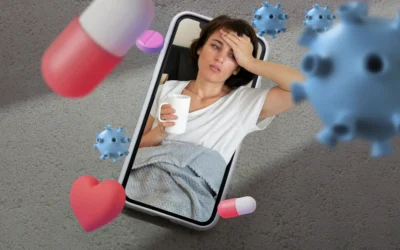Polycystic ovary syndrome (PCOS) and endometriosis are two of the most common yet often misunderstood gynecological conditions affecting women of reproductive age. They can both significantly impact fertility, hormone balance, and quality of life, but they stem from fundamentally different biological processes. Millions of women live with either PCOS or endometriosis—sometimes both—often without a proper diagnosis for years. The confusion arises because these conditions share overlapping symptoms, such as irregular periods, pelvic pain, and infertility, yet their causes, diagnostic processes, and treatments differ markedly.
Despite these differences, a unifying thread runs through both disorders: hormonal dysregulation. This shared feature underlines the importance of individualized care plans rooted in an understanding of each condition’s unique profile. In this article, we’ll explore the key distinctions between PCOS and endometriosis, covering their causes, symptoms, diagnosis, treatment options, and the latest in medical research. By the end, readers will gain a clearer understanding of how these conditions diverge and why precision in diagnosis and management is critical to improving outcomes.
In This Article
Understanding PCOS: A Multifactorial Endocrine Disorder
Polycystic ovary syndrome is a complex hormonal condition that affects an estimated 8–13% of women worldwide, though up to 70% of affected women remain undiagnosed. The term “polycystic” refers to the appearance of ovaries on ultrasound, but not all women with PCOS have cysts. The diagnosis instead hinges on a combination of symptoms: irregular ovulation, high levels of androgens (male hormones), and polycystic ovaries.
Causes and Hormonal Mechanisms
PCOS is believed to result from a combination of genetic, environmental, and lifestyle factors. At its core is a hormonal imbalance—specifically, elevated androgen levels and insulin resistance. Insulin resistance can lead to compensatory hyperinsulinemia, which further stimulates ovarian androgen production. This hormonal cascade disrupts ovulation, leading to menstrual irregularities and infertility.
Common Symptoms
PCOS symptoms vary but often include:
- Irregular or missed menstrual periods
- Excess hair growth on the face and body (hirsutism)
- Acne and oily skin
- Weight gain, especially around the abdomen
- Thinning hair on the scalp
- Difficulty conceiving
- Mood changes and fatigue
These symptoms may emerge gradually, often becoming noticeable during adolescence or early adulthood.
Understanding Endometriosis: A Chronic Inflammatory Condition
Endometriosis affects about 10% of women of reproductive age, characterized by the growth of endometrial-like tissue outside the uterus—commonly on the ovaries, fallopian tubes, and pelvic lining. This tissue behaves like the lining inside the uterus, thickening and shedding with each menstrual cycle, but without a way to exit the body, it causes inflammation, pain, and scar tissue formation.
Causes and Pathophysiology
The exact cause of endometriosis remains elusive, though several theories exist. These include retrograde menstruation (where menstrual blood flows back through the fallopian tubes), immune dysfunction, coelomic metaplasia, and genetic predisposition. Regardless of the origin, endometriosis is an estrogen-dependent condition. Elevated or unregulated estrogen levels can promote the growth and persistence of ectopic endometrial tissue.
Common Symptoms
Unlike PCOS, which may be silent for years, endometriosis often presents with severe symptoms:
- Chronic pelvic pain, especially during menstruation (dysmenorrhea)
- Pain during intercourse (dyspareunia)
- Heavy menstrual bleeding or spotting between periods
- Pain with bowel movements or urination during periods
- Fatigue, bloating, and digestive issues
- Infertility, due to scarring and inflammation
Because many of these symptoms can mimic other conditions, diagnosis is frequently delayed.
Side-by-Side Comparison: PCOS vs. Endometriosis
While PCOS and endometriosis both impact the reproductive system and share certain symptoms, the differences between them are significant in terms of pathology, diagnosis, and management. The following tables highlight their distinct features:
Table 1: Key Characteristics of PCOS and Endometriosis
| Feature | PCOS | Endometriosis |
|---|---|---|
| Primary Cause | Hormonal imbalance, insulin resistance | Estrogen-driven ectopic endometrial tissue |
| Hormone Involvement | Elevated androgens, insulin | Estrogen dependence |
| Ovarian Cysts | Multiple small follicles (not true cysts) | Endometriomas (chocolate cysts) possible |
| Cycle Irregularity | Common | Possible, but not a hallmark |
| Pain | Not a primary feature | Severe pelvic pain is central |
| Fertility Issues | Anovulation-related infertility | Anatomical disruption and inflammation |
| Age of Onset | Often in adolescence | Typically emerges in 20s–30s |
| Chronic Inflammation | Less prominent | Central feature |
Table 2: Diagnosis and Management
| Aspect | PCOS | Endometriosis |
|---|---|---|
| Diagnosis | Rotterdam criteria: 2 of 3 (irregular cycles, hyperandrogenism, polycystic ovaries) | Laparoscopy (gold standard), imaging, symptom history |
| Hormonal Tests | Testosterone, LH/FSH ratio, insulin, AMH | Estrogen, CA-125 (sometimes) |
| Imaging | Pelvic ultrasound | Transvaginal ultrasound, MRI |
| First-Line Treatment | Lifestyle changes, hormonal contraceptives | NSAIDs, hormonal therapies |
| Advanced Treatment | Metformin, fertility treatment | Laparoscopic excision surgery |
Genetic and Environmental Overlap
Emerging research suggests that PCOS and endometriosis may not be entirely unrelated. Genome-wide association studies (GWAS) have identified overlapping genetic markers, including variants in genes involved in hormone regulation and immune response. Although the conditions express differently, this genetic intersection hints at a shared susceptibility.
Environmental factors, such as endocrine-disrupting chemicals (EDCs), may also play a role in both conditions. Exposure to EDCs like BPA and phthalates has been linked to hormonal disruption, which may contribute to the onset of PCOS or endometriosis, particularly in genetically predisposed individuals.
Diagnosis: Importance of Precision and Early Intervention
One of the biggest hurdles in managing both PCOS and endometriosis is diagnostic delay. Women with PCOS often go undiagnosed for years due to normalization of irregular periods or cosmetic symptoms. Meanwhile, endometriosis patients may undergo years of painful symptoms before receiving an accurate diagnosis—largely because laparoscopy remains the most definitive diagnostic tool.
Early and accurate diagnosis is vital. In PCOS, delayed intervention can lead to metabolic complications like type 2 diabetes and cardiovascular disease. For endometriosis, unmanaged inflammation may result in irreversible damage to reproductive organs.
Treatment Approaches: Tailoring Care to the Condition
PCOS Management
Treatment for PCOS focuses on symptom management and long-term risk reduction. Lifestyle interventions, including weight management and exercise, are foundational. Pharmacological treatments may include:
- Hormonal contraceptives: To regulate cycles and reduce androgenic symptoms
- Metformin: To improve insulin sensitivity
- Clomiphene or letrozole: For ovulation induction in those seeking pregnancy
- Anti-androgens: To treat hirsutism and acne
Because of PCOS’s metabolic implications, addressing diet and physical activity is often as critical as medical management.
Endometriosis Management
Endometriosis treatment targets pain relief and suppression of ectopic tissue growth. Common strategies include:
- NSAIDs: For pain management
- Hormonal therapies: Including oral contraceptives, GnRH agonists, and progestins to suppress menstruation
- Surgery: Laparoscopic excision is often the most effective for symptom relief and fertility restoration
- Emerging therapies: Research is exploring non-hormonal options like PGES-1 inhibitors and immune modulators
Unlike PCOS, endometriosis often necessitates surgical intervention for definitive symptom control, especially in moderate-to-severe cases.
When Both Conditions Coexist
It is possible—and not uncommon—for a woman to be diagnosed with both PCOS and endometriosis. This combination presents unique challenges: the irregular cycles and anovulation of PCOS can mask the cycle-dependent pain patterns typical of endometriosis, leading to further diagnostic delays.
Management becomes more complex as treatments for one condition may exacerbate the other. For instance, hormonal contraceptives used to manage PCOS may not adequately suppress endometriosis symptoms, or they might interfere with ovulation induction efforts in women trying to conceive.
A multidisciplinary approach is often required, involving gynecologists, endocrinologists, fertility specialists, and nutritionists to create a comprehensive care plan.
Future Directions: Hope Through Research
The landscape for managing both PCOS and endometriosis is evolving rapidly. On the PCOS front, therapies like artemisinin are being investigated for their ability to reduce androgen production without compromising metabolic function. Similarly, lifestyle medicine is gaining traction, with evidence supporting the role of anti-inflammatory diets and stress management in symptom reduction.
For endometriosis, the research pipeline includes diagnostic innovations, such as saliva-based or blood-based biomarkers, and targeted non-hormonal treatments that can reduce side effects and improve long-term adherence.
Artificial intelligence and machine learning are also being applied to improve diagnostic accuracy and predict treatment response based on personalized risk profiles.
Conclusion
Although polycystic ovary syndrome and endometriosis are often mentioned in the same breath due to their effects on reproductive health, they are fundamentally different conditions. PCOS is a hormonal and metabolic disorder rooted in androgen excess and insulin resistance, while endometriosis is an inflammatory, estrogen-dependent disease driven by misplaced endometrial tissue. Each requires a unique diagnostic approach and tailored treatment strategy.
Recognizing the differences—and potential overlap—between PCOS and endometriosis is essential for empowering women to seek the right care at the right time. Continued research, awareness, and personalized medicine offer hope for better outcomes and improved quality of life for those affected.
References
Baptist Health. (2024, September 27). PCOS vs Endometriosis: Differences Explained. Retrieved from https://www.baptisthealth.com/blog/womens-care/pcos-vs-endometriosis
AUC Med. (2025, January 14). Endometriosis vs PCOS: Differences and Similarities Explained. Retrieved from https://www.aucmed.edu/about/blog/endometriosis-vs-pcos-explained
Frontiers in Endocrinology. (2024, April 29). Dissecting the shared genetic architecture between endometriosis and polycystic ovary syndrome. https://doi.org/10.3389/fendo.2024.1359236
ICON plc. (2025, March 4). Endometriosis: A research and development call to action. Retrieved from https://www.iconplc.com/insights/blog/2025/03/04/endometriosis-research-and-development-call-action
Vanderbilt University. (2024, November 18). Looking in all directions: Exploring a new horizon for PCOS therapeutics. Retrieved from https://medschool.vanderbilt.edu/basic-sciences/2024/11/18/looking-in-all-directions-exploring-a-new-horizon-for-pcos-therapeutics
World Health Organization. (2024). Polycystic ovary syndrome. Retrieved from https://www.who.int/news-room/fact-sheets/detail/polycystic-ovary-syndrome
Hudson Institute of Medical Research. (2025). Endometriosis 2025: All your questions answered. Retrieved from https://www.hudson.org.au/news/endometriosis-2025-all-your-questions-answered/










0 Comments